

The Sun has held a central place in human art and beliefs for thousands of years. This universal fascination has its roots in the fact that our star represents the very source of life on Earth. All civilizations, whether Western, Eastern or African, have developed artistic representations of the Sun that testify to its spiritual and symbolic importance.
In Greco-Roman Antiquity, the Sun takes on the features of Helios or Apollo, these majestic deities who cross the sky in a chariot pulled by four white horses. This image of the solar chariot symbolizes the perpetual movement of time and the daily cycle of light. Artists of the time represented these gods crowned with bright rays, thus embodying divine power, clarity and vitality.
Ancient Egypt offers us another fascinating vision with Ra, the solar god wearing a golden disk. Egyptian representations often associate the Sun with the scarab or the falcon, creating deep symbolic links with themes of rebirth and regeneration. This iconography still influences our understanding of the Sun as a force of renewal today.
East Asia develops its own artistic codes around the Sun. In China, Japan and Korea, mythology evokes a three-legged crow that carries the sun in its claws. This mystical creature symbolizes not only light and life, but also control over time and seasons. In Japan, Amaterasu, the solar goddess, reigns as the supreme deity of the Shinto pantheon, testifying to the importance given to solar energy in Japanese spirituality.
These Eastern representations bring a particular dimension: they emphasize the cyclical and rhythmic aspect of solar influence, preparing the ground for more subtle interpretations of solar symbolism.
Medieval and Renaissance West perpetuates this tradition by adapting solar symbolism to the Christian and royal context. The Sun becomes an emblem of divine and earthly power. Illuminations, frescoes and stained glass windows of cathedrals naturally integrate solar motifs, often associated with divine light or revealed truth.
The most famous example remains that of Louis XIV, the Sun King, who makes the Sun his personal emblem. This royal identification transforms the star into a symbol of supreme authority and legitimacy of power. The architecture and decorative arts of Versailles still testify today to this symbolic appropriation.
One of the most touching representations of the Sun in art consists of giving it a human face. This anthropomorphization, which we find in ancient frescoes, medieval stained glass and even on coins, responds to a deeply human need: that of establishing a personal relationship with cosmic forces.
The solar disk adorned with eyes, a nose and a mouth expresses the benevolence and consciousness attributed to the star. This representation suggests that the Sun does not simply mechanically illuminate the world: it sees, understands and watches over humanity. The rays that surround this face often alternate between straight forms, symbolizing pure light, and wavy ones, evoking life-giving warmth.
The motif of the radiant Sun crosses all artistic eras. From Mesopotamian symbols to royal emblems, this representation expresses the idea of radiance in both literal and metaphorical senses. Triangular rays evoke direct light and mental clarity, while wavy rays suggest warmth and vital energy that circulates.
This iconography directly influences religious representations: the halos and nimbi that surround the heads of saints in Christian art derive directly from this pagan solar tradition. Byzantine art particularly develops this symbolism, creating mosaics where golden light evokes spiritual illumination.
Renaissance Italy constitutes the cradle of tarot, and the first THE SUN cards testify to remarkable creativity. Around 1475, at the court of the Duke and Duchess of Milan, artists create a hand-painted card that reveals a sophisticated approach to solar symbolism. This work presents a putto (winged child from ancient mythology) crossing the sky on a cloud, holding above his head the mask of Helios, the Greek god of the sun.
This fascinating representation mixes Christian tradition and ancient mythology in a way typical of the Italian Renaissance. The putto, a familiar figure in religious art, becomes here the bearer of pagan wisdom embodied by Helios. This synthesis reveals how artists of the time naturally integrated multiple cultural heritages into their creations.
Another Sun card, created in the middle of the 15th century for the Duke of Ferrara, illustrates one of the most famous anecdotes of Antiquity: the meeting between Alexander the Great and the cynic philosopher Diogenes. This story, reported by Plutarch and taken up by Shakespeare, tells how Diogenes, living in a barrel by philosophical choice, asked the emperor to step aside because he was casting shade on him.
This scene on a Sun card is not insignificant. It perfectly illustrates the value of natural light compared to earthly honors. Diogenes, by simply asking that the sun continue to illuminate him, establishes a hierarchy of values where authentic light takes priority over political power. This philosophical interpretation considerably enriches the symbolism of the card.
Bologna develops its own iconography with a seated woman holding a distaff and a spindle. This image quickly becomes standard in this region, as evidenced by the Dalla Torre card printed in the 17th century.
The distaff and spindle deserve particular attention. In pre-modern Europe, seeing a woman spinning while walking, tending her animals or waiting for porridge to cook was a daily sight. The spindle thus becomes the symbol of the respectable and hardworking housewife. This symbolism naturally links to the Sun: just as the star makes its daily revolution in the sky, the spindle turns regularly, reminding us of the importance of using daylight hours to accomplish one's work.
The Budapest tarot, printed in Italy just before 1500, presents a more natural vision with a benevolent sun pouring its life-giving rays on a forest or orchard. This direct representation, without human characters, emphasizes the nourishing function of the sun.
This approach reminds us that the Sun, before any complex symbolic interpretation, remains the primordial source of life on Earth. The rays that fall on the trees evoke photosynthesis and the vital cycle, anchoring the card in a tangible reality that speaks to each of us.
The oldest known Sun showing a woman with distaff and spindle appears in the famous Charles VI tarot, painted for an Italian aristocrat in the middle of the 15th century. This card establishes a deep symbolic link with Clotho, one of the three Fates of Greek mythology who spins the thread of individual destiny.
This association transforms the simple spinner into a cosmic figure. The woman under the sun no longer simply spins wool: she literally weaves the thread of human destiny. The sun that illuminates her then becomes the benevolent witness of this fundamental work, reminding us that each day brings its share of building personal destiny.
The Paris Tarot, printed around 1615, presents a surprising interpretation of the THE SUN card. This French version shows a monkey holding a mirror in front of a woman with particularly long hair. This composition probably constitutes an allegory of Vanity, a theme highly prized in European art of the time.
This representation reveals how French creators of the time adapted tarot symbols to the moral concerns of their time. The monkey, an animal traditionally associated with imitation and human flaws, becomes here the revealer of deceptive appearances. The mirror, for its part, symbolizes vanity but also the necessity of self-knowledge, creating a rich symbolic tension between illusion and truth.
The sun projects multicolored arrows of light - and not drops as we saw in the article on 18 - THE MOON. This representation fits into the cosmological vision of the time when stars literally radiate their influences towards the earth.
The low wall made of multicolored blocks strikes with its kaleidoscopic aspect. This colorful construction could symbolize the diversity of human experiences that form the foundations of our psychological development. However, some might see instability in it, a heterogeneous construction that lacks unity - a perspective that would nuance the apparent optimism of the scene.
The man, located on the left, wears clothes and displays a fascinating detail: one leg of light blue color and the other of flesh pink color, as if he were literally divided, cut in two. This chromatic duality evokes a being in transition, still divided between different aspects of his personality.
He seems to wear a red collar with a link that descends, probable reference to the chains of 15 - THE DEVIL, but indicating here that this servitude belongs to the past - the man is now free. I recognize however that one can have doubt about the presence of this collar: in later versions of the Tarot of Marseille, this element will be better drawn and represented. My interpretation is based on my knowledge of other Marseille tarots that confirm this symbolism.
This representation raises interesting questions: why does the man keep clothes while the woman appears naked? This asymmetry could reflect social conventions of the time, but also suggest that the man still has defenses to abandon, masks to remove.
The woman presents herself entirely naked - her flesh pink colored body testifies to this nudity - except for a modest veil around the hips. She also wears a red collar, recalling her former condition of submission to the Devil, but this mark of the past seems less constraining than for the man.
The most revealing element remains the body of water at the couple's feet. On the original card preserved at the National Library of France, this detail can barely be distinguished because aging makes the green of the ground merge with the dark blue of the water. Fortunately, Jean Claude Flornoy, who restored this tarot, shows it clearly with more visible colors.
This body of water reveals a crucial difference: the man seems at the water's edge, while the woman has one foot in the water. This position suggests that the woman maintains a more direct connection with the aquatic element, symbol of the unconscious and emotions. My hypothesis is that the woman represents the crayfish from 18 - THE MOON who can now come out of the water and take human form, having been appeased and accepted.
This innovative vision will influence later creations. When the Tarot of Marseille becomes popular in Italy in the 18th century, Italian card makers adapt certain images to local tastes. The Piedmontese deck shows a couple who hold each other rather awkwardly, reminiscent of the two boys from the traditional Tarot of Marseille. Later, the Soprafino deck of 1835 by Carlo Della Rocca presents a well-dressed couple dancing in an enclosed garden - an image taken up by printers of Lombardy and Piedmont throughout the 19th century.
If you look carefully at the card, the character on the right has only one eye open, the other is closed, as if he were partially blind. This troubling detail suggests incomplete or altered vision, perhaps evoking the limits of human perception faced with divine light. This ocular asymmetry could symbolize the transition between past blindness and future clairvoyance, or conversely reveal that even in solar joy, our vision remains partial.
Dodal introduces a major modification: two children replace the adult couple. This transformation proves decisive, as this imagery becomes the standard European representation for four centuries. This standardization reveals moreover a symbolic simplification which, if it facilitates interpretation, can also impoverish the psychological richness of Noblet's original vision.
These two children evoke the twins of mythology, notably Castor and Pollux. These heroes possess attributes that connect them perfectly to the Sun card: they excelled in horsemanship and Pollux was a boxing champion, activities associated with Children of the Sun in Renaissance astrological tradition. The myth of their mutual sacrifice - Pollux sharing his immortality with his mortal brother - resonates with the theme of transcendent fraternal love present in the card.
The Renaissance firmly believed in "Children of the Planets," the idea that a planet governs destiny and influences the personality, occupation and physical appearance of each individual. This astrological doctrine deeply structured the worldview of the time, influencing art, medicine and social relations. Children of the Sun, like the star that governs them, distinguished themselves by their natural charisma, their noble rank and their ability to naturally become the center of attention.
This planetary theory explains why illustrations of "Children of the Sun" always showed young aristocrats practicing high society sports like fencing, wrestling, gymnastics and weightlifting. These noble physical activities contrast with the more contemplative image we might have today of solar fulfillment. This athletic dimension reminds us that the Sun also symbolizes bodily vitality and physical performance.
Paradoxically, this standardization of the two children, if it democratizes symbolic access to solar happiness, can also trivialize it. Childish innocence, though touching, risks masking the complexity of the psychological integration processes that Noblet's more sophisticated version suggested.
Around 1650, Jacques Viéville publishes in Paris a revolutionary version: a naked young man brandishes a banner while galloping across a field on a pale horse, under a blazing sun. This imagery, taken up in the Rouen-Brussels model popular in Belgium and northern France until the middle of the 18th century, introduces symbols that will later influence French and British occultists.
The banner held by the young man in the Vandenborre version displays a red cross on a white background. This ensign, carried into battle by the crusaders, also appears in representations of the risen Christ emerging from his tomb to symbolize his victory over death. Occultists will later interpret this young man with the banner as a soul liberated from the material world, about to be carried away to the heavens.
What I find strange about this approach is that this same banner is used in the following card XX - JUDGEMENT, much more pertinently. So why this redundancy and use this same symbol in both cards (which Vieville and Vandenborre do)?
Wirth goes further by representing the children of the Sun as a young boy and a young girl on whom celestial gold rains. In his vision, the nineteenth arcanum represents a stage where humanity has not yet accessed the heavens. The wall behind the children indicates that the soul still remains in the material world. The sun maintains this anchoring in the visible, because at this stage, the spirit remains imprisoned in a body in the process of purification before being able to unite with the Universal Spirit.
In the Order's deck, the iconography remains close to the Tarot of Marseille: a naked boy and girl hold hands in front of a wall. However, significant details appear: the boy stands on green grass while the girl is in a pool of water. The drops falling from the sun transform into Yods, the first letter of God's name in Hebrew, adding an explicit sacred dimension.
In Waite's vision, the enclosed garden behind the stone wall represents our material world illuminated by the earthly sun. The child rides away from the wall because he has been liberated and makes the transition from this world to a transcendent realm. Waite affirms that transformed humanity becomes simple and innocent again like a naked child. Perfect harmony is established between transformed consciousness and animal nature, symbolized by the perfect accord between the child and his mount.
The Rider-Waite-Smith introduces a new visual element: four sunflowers in the garden. These flowers, which naturally follow the sun's course, symbolize the four elements and the four suits of the tarot, reinforcing the universal and cyclical dimension of the Sun. This innovation considerably enriches the symbolism of the card by integrating a direct reference to the very structure of the tarot.
The Rider-Waite-Smith definitively transforms the modern perception of THE SUN card. By moving from collective representation (two children) to individual experience (one child alone), Waite creates more narrative and psychological imagery.
This tarot presents an interesting feature by featuring a woman and a man rather than the traditional two children. This approach echoes Jean Noblet's original vision and deserves to be highlighted as it is so rare in contemporary creations. This representation of the couple resonates deeply with the psychological understanding I develop concerning THE SUN as you will read in the section below 'What the card is not'.
This version presents an enigmatic composition with human silhouettes sitting on birds perched on branches, surrounding a central sun accompanied by mysterious symbols. While this aspect remains difficult to fully decode, one particular element catches my attention.
The image representing a pile of papers held together by string constitutes a real symbolic find. This patchwork metaphor resonates perfectly with the deep nature of THE SUN: that of a stage where we manage to bring together different and disparate aspects of our personality to live them harmoniously. This vision of the unified self but composed of multiple facets corresponds exactly to the work of psychological integration that this card represents (see section below 'What the card is not').
This contemporary approach responds to current identity challenges, where the individual must deal with multiple and sometimes contradictory influences. The symbolism of the "coherent whole" formed of diverse elements offers an optimistic perspective on modern identity complexity.
This tarot is distinguished by its ultra simple and basic symbolism, presenting a human silhouette of childlike appearance turning its back on an omnipresent sun. This white sun, dazzling like a flash, occupies a large part of the image while the silhouette raises its arms, seeming to seek protection from this excessive light.
This representation dares to propose an image that is not ultra positive of the sun, adopting a much more neutral, even negative symbolism. This courageous approach reminds us of a fundamental truth: by staring at the sun too much, we burn our eyes and become blind. This visual metaphor brilliantly evokes the dangers of blindness from excessive confidence, vanity or superficiality.
This nuanced vision enriches our understanding of the traditional reversed aspects of the card, by integrating them directly into the iconography. It reminds us that even the most beneficial energies can become destructive in excess.
This version presents a card that is not so positive, with a sun with a grimacing face and closed eyes. The two characters transcend the simple representation of children to embody very contradictory and opposite aspects: one with white skin, the other with black skin. This chromatic duality constitutes a beautiful alternative to the traditional man/woman couple.
The black character, possible resurgence of the Jungian Shadow, holds a small sickle suggesting that he has just cut the bonds of servitude (reference to THE DEVIL). His other hand plunges into the belly of the white character, evoking better the symbolism of fusion and mixing than the simple traditional contact. This gesture, though troubling, illustrates the intensity of the integration process.
The black character has a mask reminiscent of the human skull with horns, directly evoking traditional diabolical iconography. This mask, half broken, reveals the black skin of his face, creating a progressive unveiling effect. The fact that the real face appears under the broken mask evokes a process of authentic revelation, where the dark aspect of the psyche abandons its frightening disguises to reveal its true nature.
The white character (probably inspired by the putto - winged child from ancient mythology - as mentioned previously), with angelic wings and carrying a lyre, grips his partner's neck rather than simply placing his hand on his shoulder. This gesture reveals the possessive or appropriative nature inherent in the symbolism of the Sun. Particularly interesting: this luminous character has half of his face black in color, as if contaminated by his partner, evoking the fusion of opposites in the manner of the Yin Yang symbol.
The detail of the feet in a plate of water reveals that the creator knows Jean Noblet's tarot and understands its symbolic scope. This reference anchors the modern creation in historical tradition while renewing it.
While this image tends toward a rather negative evocation that I don't necessarily appreciate, I must recognize that the symbolism of this card demonstrates on the author's part a true understanding of the deep symbolism of THE SUN. This version courageously explores the shadow zones of psychological integration, even if it may disturb by its dramatic intensity.

Key words for the 78 cards for the Tarot of Marseille and the Rider-Waite-Smith, to slip into your favorite deck. Your leaflets always with you, at hand, to guide you in your readings. Thanks to them, your interpretations gain in richness and subtlety.
Many people perceive THE SUN as the card of charisma, optimism and radiance toward the outside. By carefully observing the Tarot of Marseille with its two children, I notice that this perception must be tempered. This card first evokes candor, freshness and innocent joy.
More fundamentally, a false idea circulates concerning this card. Just as 18 - THE MOON is often seen as a card of internalization, THE SUN appears as a card of externalization. In reality, both cards function as cards of internalization. They both speak to us about what happens inside us. This supposed extraversion that could characterize THE SUN is only a consequence of what develops deep within our being. What we emit toward the outside only reflects our inner transformation.
To understand what really happens at the psychological level, we must retrace the path traveled since 15 - THE DEVIL. With 16 - THE TOWER that follows the Devil, we realize how much we have lost ourselves and how our excessive ego has deteriorated our relationships with others.
17 - THE STAR marks the beginning of this reconstruction: we find the path of virtue again. In this card, the woman who pours water with her amphoras actually creates the lake we see in THE MOON. We can also say that she "breaks her waters," and the crayfish in the lake could symbolize the embryo in the amniotic fluid - our inner child in formation.
My particular vision concerns this crayfish visible in THE MOON. Contrary to traditional interpretation which sees it as a symbol of the sign of Cancer or a representation of primitive fears, I propose another reading: the star is giving birth, and what she brings into the world is found in the waters she has poured. The crayfish thus becomes our deeply wounded inner child - this capricious child who had manifested in the form of THE DEVIL.
With 18 - THE MOON, we must let our wounded inner child rise to the surface in order to purify and liberate it. This phase represents a crucial stage of psychological integration where we stop repressing our wounded aspects to welcome them consciously. This process requires much courage because it involves reconciliation with our shadow parts.
With 19 - THE SUN, having accepted our Jungian Shadow, we face our Animus/Anima. Here, because the Master Craftsmen were men, they primarily symbolized a process of encounter with the Anima. In Jean Noblet's tarot, we can clearly see that the man and woman do not have the same function. Beyond the complementarity of masculine and feminine poles, it seems that the man must undress, strip naked, while the woman already is.
Moreover, the woman seems to emerge from the water or be connected to water, while the man is clearly at the edge. This is why I think Jean Noblet wanted to tell us that the woman is the crayfish who can now come out of the water and take human form because she was appeased and accepted. Thus the man must continue his path by integrating his Anima after having integrated his Jungian Shadow.
You will tell me that I contradict myself, because indeed a few lines above, I say that the crayfish at the bottom of the lake is the inner child who has just come out of his mother's womb. In truth, there is indeed a chronology Shadow → Animus/Anima → Inner child (and at this stage, I should not yet speak of the Inner child), but we arrive at a stage where evolutions and transformations become all the more subtle as they are profound. Already we are talking about the same process during these 3 stages: integration. And it happens in parallel, because the 3 archetypes Man/Woman/Child are present at the same time within our psyche. It's just that they don't cohabit harmoniously.
Jean Noblet probably had a very egalitarian perception of the role of man and woman. He was perhaps a feminist ahead of his time. I also think that intuitively, he had understood well before Carl Jung that the human psyche was structured around three archetypal poles: Man, Woman, Child, each pole representing a group of specific values.
Jean Noblet had probably perceived the difficulty of admitting, accepting, even highlighting, a "sensitivity" and character traits that we still consider today as feminine. He had understood that the man, woman and child in us had trouble cohabiting and getting along - exactly like in a real family. Having arrived at this perception of his interiority, he had certainly thought that an important step toward spiritual realization was the man/woman harmony within us.
The other master craftsmen clearly did not have such an approach. By putting two children in place of the man and woman, they highlighted the qualities of the inner child: the qualities of candor, innocence, purity of heart. This was probably to bring the scene of the card as close as possible to the themes and symbolism of the sun. I think there was a cultural and societal bias, where the master craftsmen acted according to their education and culture of the time.
I think Jean Noblet was right. I am personally convinced that THE SUN works better when the image features a man and a woman, and not two children. What makes me definitely say this is 20 - JUDGEMENT, where we see a character emerging from a tomb. Here we must really see the rebirth of the inner child - an inner child healed of its wounds - who joins the two parents.
According to me and apparently Jean Noblet, the card of the inner child is JUDGEMENT, and not THE SUN. The two children in THE SUN are there too early, because at this moment the individual is not ready to welcome their inner child. Why? Because they are still in their role and stature as an adult: "What? I'm not going to listen to a child, I can see what that did with THE DEVIL. Out of the question to fall into the trap again, no I will not listen to my inner child, it causes havoc."
At the moment of THE SUN, the individual is still exactly in this interiority. This is why the man and woman must talk to each other and make peace, to become lovers again, so that the new child can come in JUDGEMENT.
This understanding reveals that THE SUN represents a crucial but transitional stage: that of inner reconciliation of polarities that will then allow the emergence of a renewed and balanced inner child.
| Symbolic interpretation | Right direction (Positive) | Will, confidence, nobility, honor, growth, joy, pleasure, success, wealth, protection, mutual help, brotherhood, warmth, peace, gold, luxury | Reverse direction (Negative) | Blindness, pride, showing off, pretension, bluff, anger, control, intolerance, self-centeredness, sterility |
| Psychological interpretation | Right direction (Positive) | Confident, optimistic, loyal, faithful, honest, reasonable, sincere, creative, generous | Reverse direction (Negative) | Shallow, uninhibited, actor, wealth show-off, greedy, vain |
| Advice | |
| Be bright like the sun and shine with joy. Share your light. Develop your charisma. Happiness doesn't wait, enjoy the present moment and daily joys. Give without expecting anything back | |
| Thematic Interpretation | Love | Marriage coming. Shared love. Romantic relationship. Partner on a pedestal. Interested or greedy partner | Work | Successful teamwork. Recognition from management. Promotion. Desired position. Carelessness at work | Money | Profitable work. Sponsorship. Spending nature. Flashy attitude | Family / Friendships | Brotherly friendship. Joyful family atmosphere. Paternalism. Spoiled child. One-sided relationship | Health | Excellent vitality. Optimism in healing. No foresight or prevention. Denial of illness or diagnosis |
| Divination / Prediction | Who ? | A charismatic person. An extravagant personality. A proud individual. A patriarch. A father. A boss | Where ? | A theater. A stadium. A vegetable garden. A beach. The desert. The marriage bed | When ? | A speech. A show. A concert. A family activity. Summer. A trip to the south | How ? | By surrendering to the other. By getting naked in front of them. By giving everything to them. By trusting them completely |
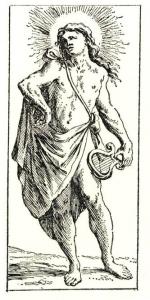
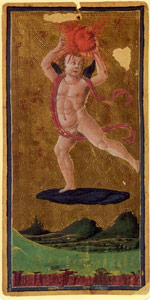
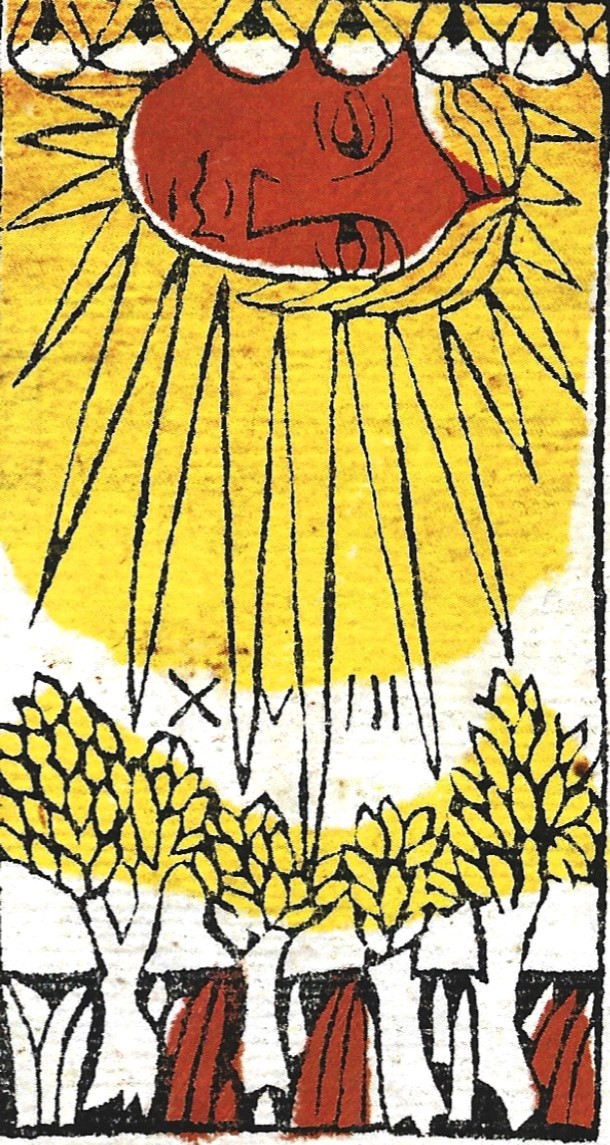
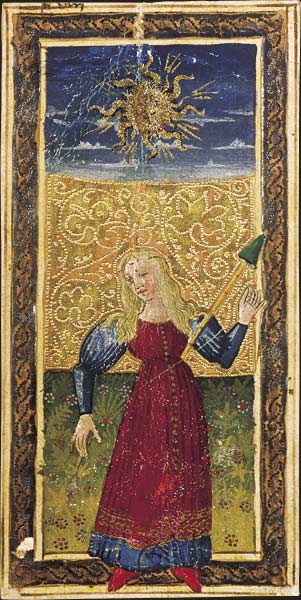

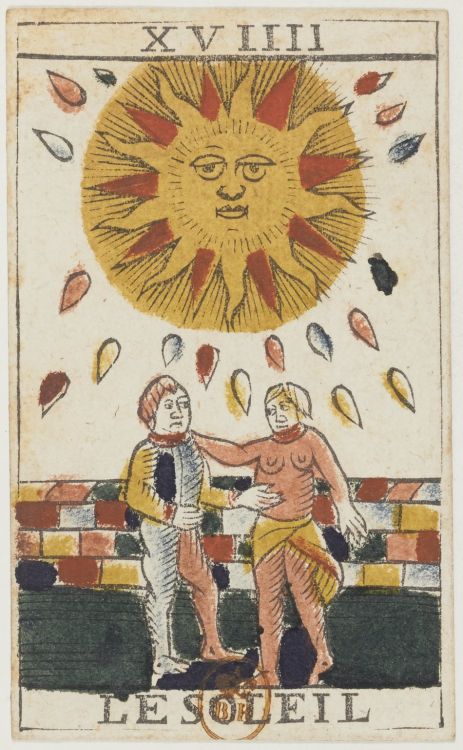
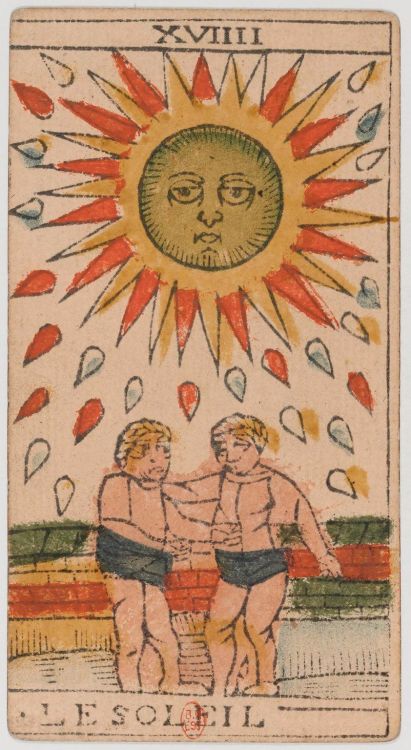
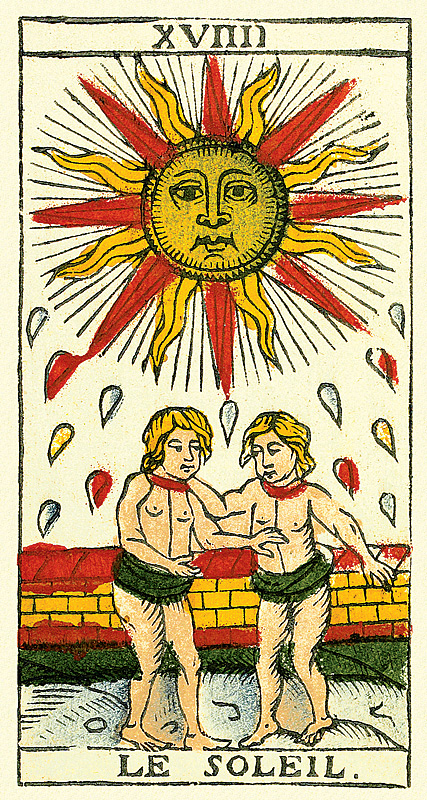

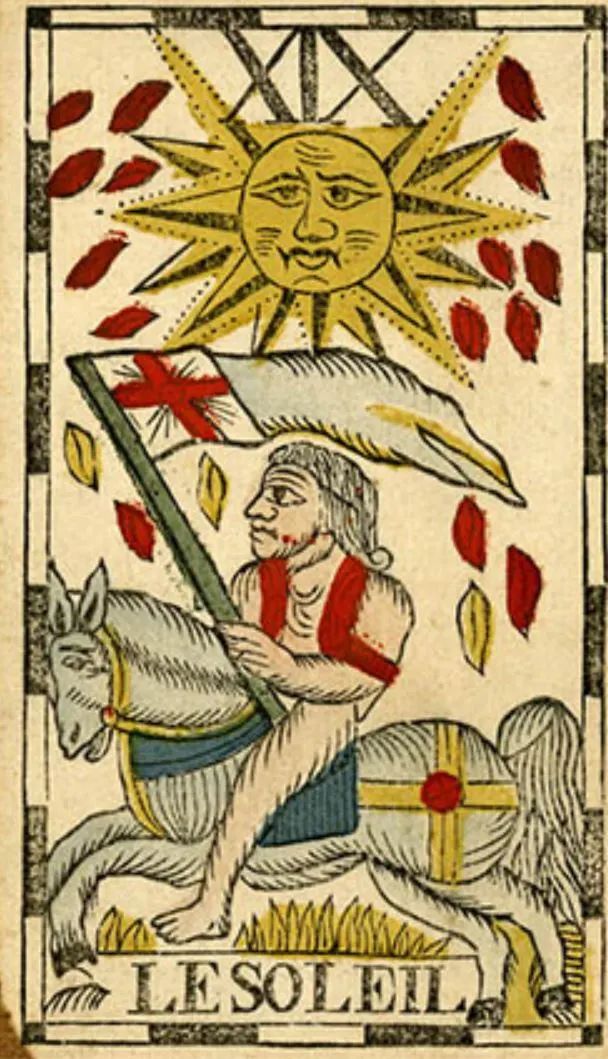
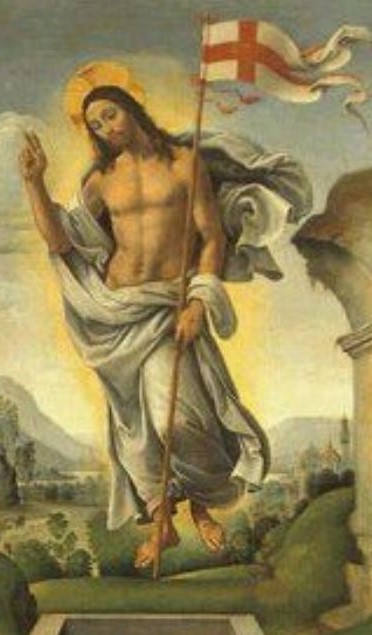
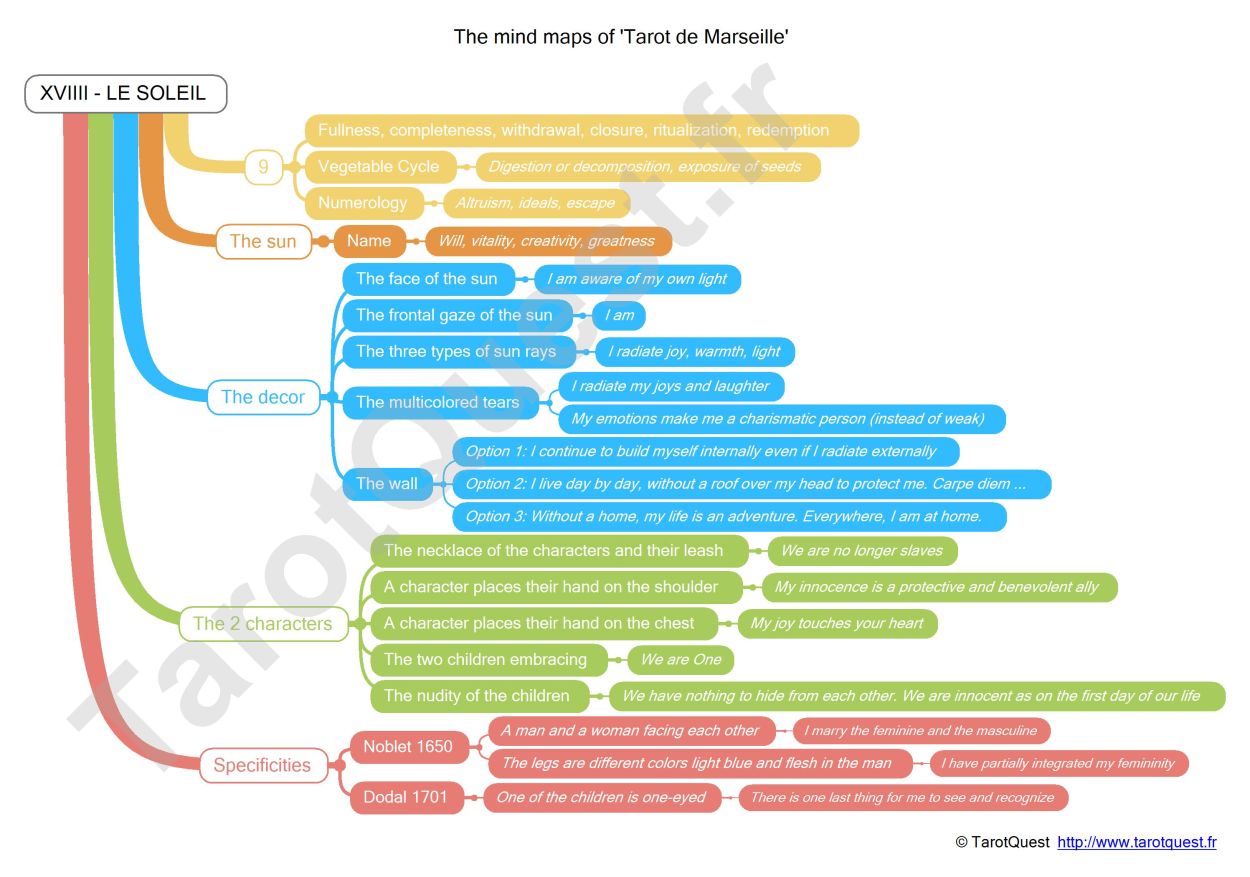

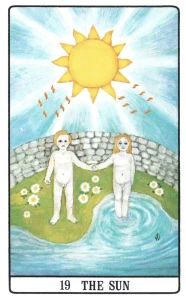
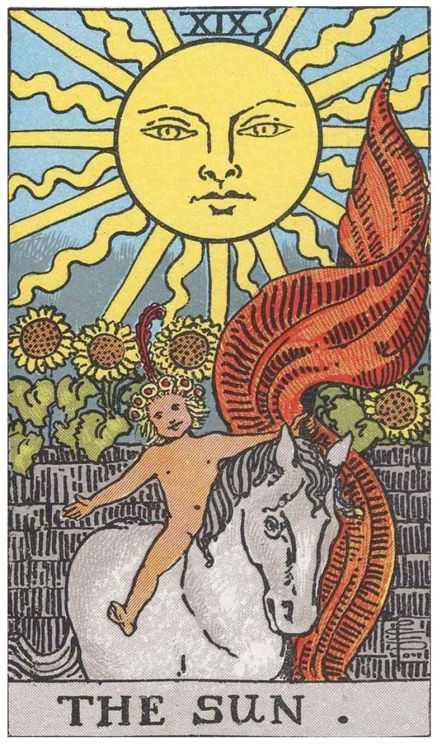

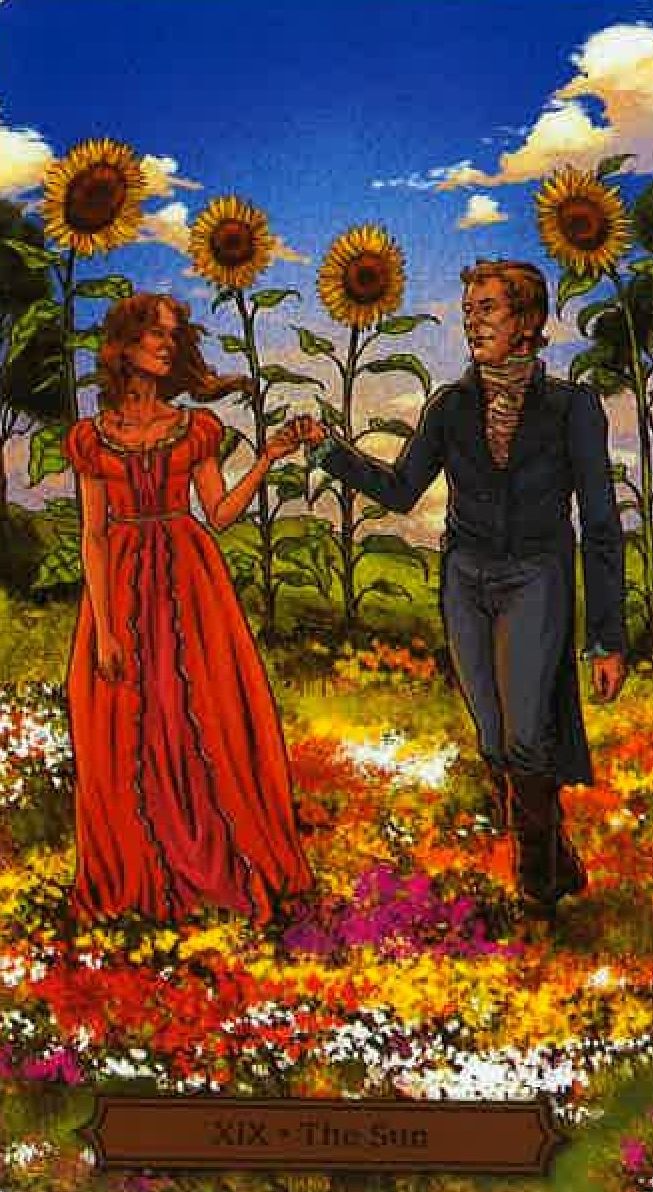
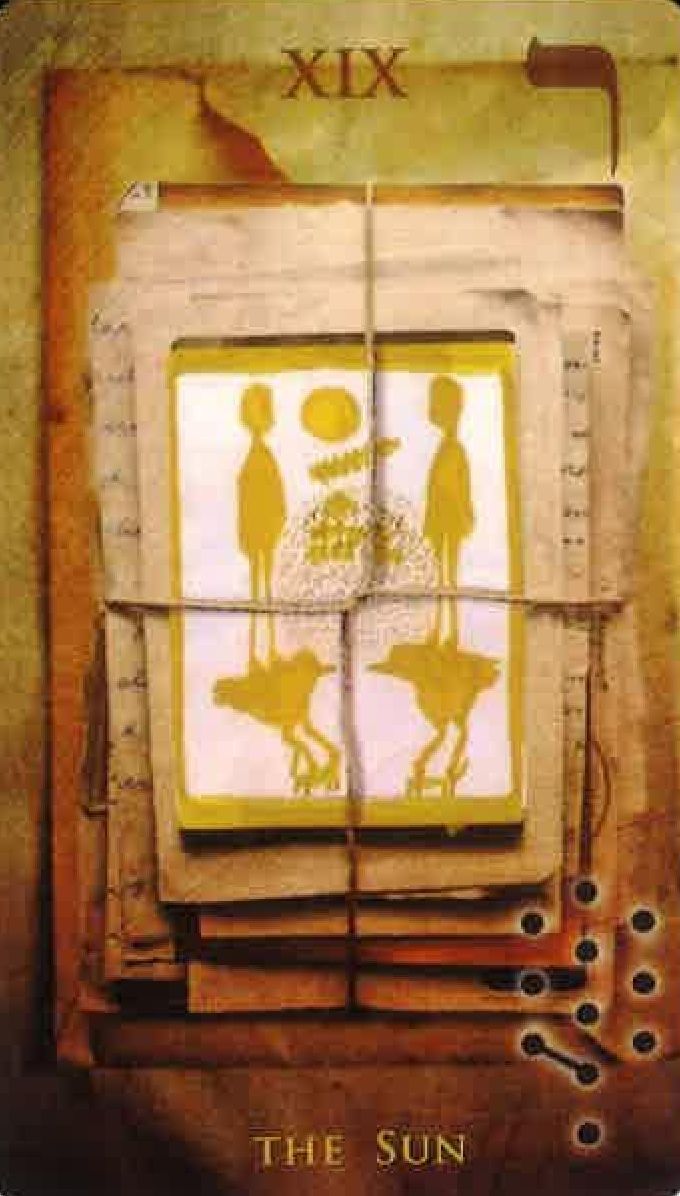
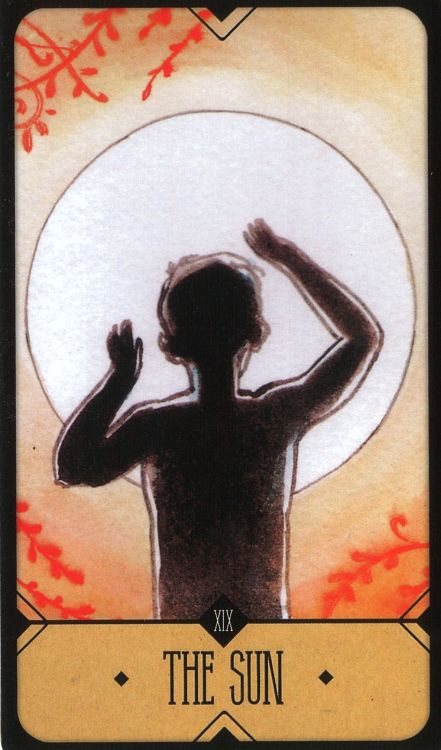
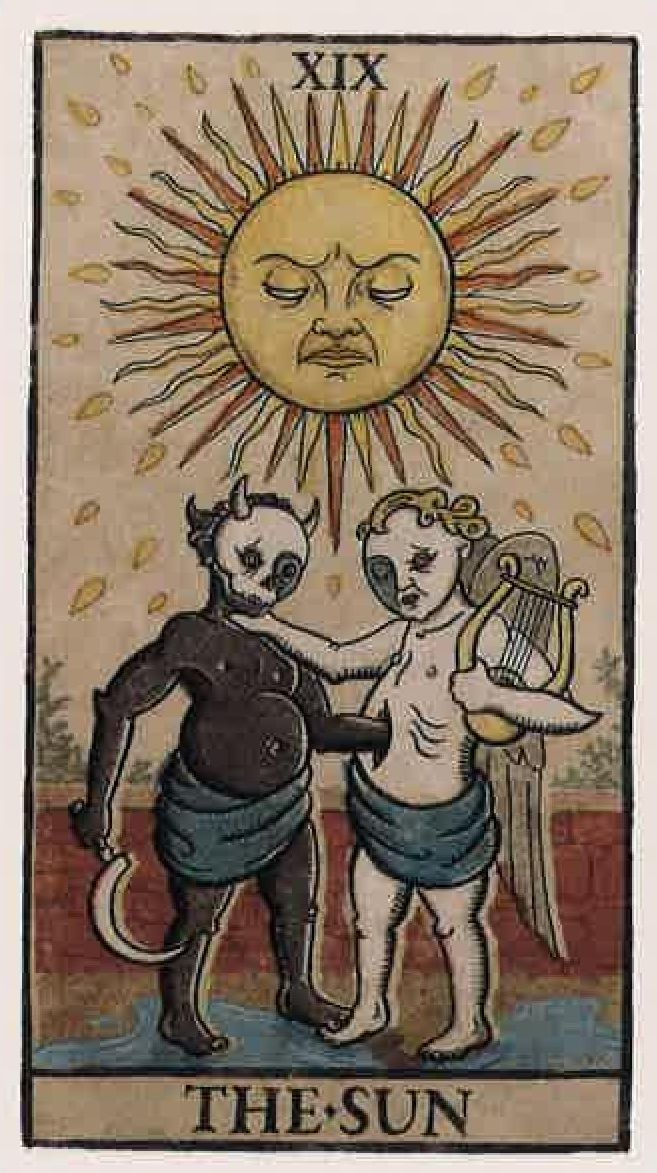
Copyright © TarotQuest.fr